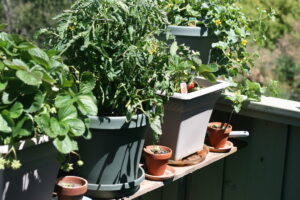
Key Takeaways
-
Biochar has potential risks that can affect soil health, water quality, and air purity.
-
Understanding biochar’s potential toxicity is crucial for safe application in agriculture.
-
Environmental implications of biochar include the possible release of greenhouse gases and alteration of soil microbial communities.
-
Economic considerations must be taken into account to determine if biochar is a cost-effective solution for gardeners and farmers.
-
Regulations and best practices are essential for minimizing the risks associated with biochar production and use.
As we delve into the world of sustainable gardening or farming, it’s essential to explore every angle of the practices we adopt. Biochar, a charcoal-like substance made from biomass through pyrolysis, has been gaining attention for its soil amendment properties. But with every innovation comes a set of considerations, and biochar is no exception.
What Exactly is Biochar?
At its core, biochar is a carbon-rich product derived from organic materials like wood, manure, or leaves, which are heated in a low-oxygen environment. This process, known as pyrolysis, transforms the biomass into a stable form of carbon that can persist in soil for hundreds to thousands of years. The charm of biochar lies in its ability to improve soil fertility, increase crop yields, and sequester carbon, potentially mitigating climate change.
Shining a Light on Biochar Benefits
Before we tackle the potential downsides, let’s appreciate the positives. Biochar can be a game-changer for soil health. It improves water retention, helps with nutrient absorption, and can even detoxify soils by binding to harmful pollutants. These benefits can lead to healthier crops and a more robust ecosystem. Most importantly, biochar is championed for its ability to lock away carbon dioxide, offering a proactive approach to combat global warming.
The Dark Side of Biochar
Now, let’s turn the soil and look beneath the surface. While biochar can be beneficial, we need to understand its potential risks fully. The focus here is not to deter you from using biochar but to ensure you’re equipped with the knowledge to use it wisely and safely.
Toxic Trail: The Health Hazards Hidden in Biochar
One of the primary concerns with biochar is its potential to harbor toxic substances. Depending on the feedstock and the pyrolysis conditions, biochar can contain heavy metals and polycyclic aromatic hydrocarbons (PAHs), which are known to be harmful to both human health and the environment. If these toxins leach into the soil, they can contaminate crops and enter the food chain.
Therefore, it’s imperative to source biochar from reliable producers who use clean feedstock and controlled production processes. Always test biochar before applying it to your fields, and make sure it meets the International Biochar Initiative (IBI) standards for safe use.
Environmental Pitfalls: When Biochar Does More Harm Than Good
Beyond the health hazards, biochar’s environmental impact can be a double-edged sword. For instance, if not managed correctly, biochar can become a source of greenhouse gas emissions rather than a solution. When biochar decomposes, it can release carbon dioxide and methane into the atmosphere, counteracting its carbon sequestration benefits.
Moreover, biochar can affect the delicate balance of soil microorganisms. While it can promote beneficial microbial communities, it may also suppress others, potentially disrupting soil ecology. This alteration can have a ripple effect on soil fertility and plant health, which are the very aspects biochar is supposed to enhance.
Because of these potential environmental impacts, it’s crucial to approach biochar application with caution. Monitor your soil’s response to biochar, and consider consulting with soil scientists to ensure that you’re contributing positively to your ecosystem.
Harvesting Woes: Biochar’s Impact on Soil Fertility and Crops
Another concern that warrants attention is biochar’s influence on soil fertility and crop outcomes. While biochar can be rich in nutrients, its application must be tailored to the specific needs of the soil. Excessive use of biochar can lead to nutrient imbalances, affecting the availability of essential minerals such as nitrogen and phosphorus. This imbalance can negatively impact crop yields and quality, which is the opposite of what we aim to achieve with sustainable farming practices.
Economic Impacts: Counting the Cost of Biochar Use
Let’s talk numbers. The economic viability of biochar hinges on several factors, including production costs, market demand, and the scale of its application. The initial investment in biochar can be significant, especially for small-scale farmers. You need to consider the cost of purchasing biochar, the potential need for specialized application equipment, and any additional labor costs.
Expense vs. Efficiency: Is Biochar Cost-Effective?
Is the juice worth the squeeze? To determine if biochar is cost-effective, weigh the long-term benefits against the initial expenses. Biochar’s ability to improve soil health and increase crop yields could lead to higher profits over time. However, this is not a one-size-fits-all solution. The efficiency of biochar use depends on the type of crops you grow, the condition of your soil, and how well you integrate biochar into your gardening or farming practices.
Several studies have been conducted on the effectiveness of biochar with various crops, including corn, soybeans, wheat, and other agricultural products. Here are some key findings from the available research:
Maize (Corn) and Rice Yield: A study suggested that the application of biochar and rice husk charcoal could be used as an alternative to improve maize yield. Additionally, biochar can prevent soil sulfonamides from accumulating in rice tissues.
Wheat and Corn Yields: Biochars derived from agricultural waste, such as wheat and corn, have been shown to enhance crop yields. For instance, biochar application significantly increased wheat leaf, stem, straw, and grain nitrogen content, as well as grain and total nitrogen uptake.
General Impact on Crop Yields: Overall, biochar has been found to have beneficial effects on soil quality and crop yields. However, the specific impact can vary based on factors such as climate, crop type, and soil, and the variability of biochar properties should be viewed as its best asset.
While the studies provide insights into the potential benefits of biochar for various crops, the specific type of biochar that is most effective for each crop may require further research and consideration of multiple factors, including soil conditions, climate, and crop characteristics.
The Market Maze: Navigating the Biochar Industry’s Volatility
The biochar market can be as unpredictable as the weather. Prices for biochar fluctuate based on availability, quality, and competition in the market. If you’re a sustainable farmer, it’s crucial to stay informed about market trends and to source biochar at a cost that makes sense for your operation. Build relationships with suppliers, and consider joining a cooperative to gain bargaining power and access better prices.
Understanding Biochar Standards and Safeguards
Ensuring that biochar is produced and used responsibly is paramount. International standards have been set to guide the production and application of biochar, aiming to protect both the environment and end-users. Familiarize yourself with these standards to ensure the biochar you use is not only effective but also safe for your land, your community, and the environment.
Policing Biochar: Regulations and Compliance
Regulatory oversight of biochar varies by region, but there are general guidelines and certifications that you should be aware of. The International Biochar Initiative (IBI) offers a certification program that sets benchmarks for the quality and safety of biochar. Adhering to these regulations not only ensures compliance but also instills confidence in your customers that you are using a product that is both safe and sustainable.
It’s also important to stay abreast of local and national regulations regarding biochar use, as these can impact your gardening or farming operations. Ensure you’re in compliance with any environmental regulations, and take advantage of any governmental incentives for using eco-friendly practices like biochar application.
Lastly, consider the potential liability issues. If biochar application leads to negative outcomes, such as crop failure or environmental damage, you could face legal repercussions. It’s vital to have a thorough understanding of the risks and to implement risk management strategies.
-
Get to know the IBI standards for biochar quality.
-
Stay updated on local, national, and international regulations concerning biochar.
-
Consider potential liability and implement risk management strategies.
Best Practices for Safe Biochar Production and Use
As a responsible steward of your land, it’s up to you to ensure that the biochar you use is produced and applied in a manner that safeguards your crops, your soil, and the wider environment. Here are some best practices to follow:
-
Source biochar from reputable suppliers who use clean feedstock and environmentally responsible production methods.
-
Test biochar for contaminants such as heavy metals and PAHs before application.
-
Apply biochar according to soil test recommendations to avoid nutrient imbalances.
-
Monitor soil and crop responses after biochar application to assess its effectiveness and make necessary adjustments.
-
Keep records of biochar applications, including amounts, dates, and observed effects, to inform future use and share with the farming community.
Adopting these practices not only promotes the safe use of biochar but also contributes to the overall sustainability of your operations. By doing so, you’ll be part of a growing community of gardeners and farmers who are not only feeding the world but also nurturing the planet.
FAQs
Can Biochar Be Produced Without Health Risks?
Yes, biochar can be produced with minimal health risks if the production process is carefully managed. Choosing the right feedstock—free from contaminants such as treated wood or plastics—is crucial. Additionally, controlling the pyrolysis temperature ensures that harmful compounds are not formed. Using modern, controlled pyrolysis units can significantly reduce the potential health risks associated with biochar production.
Do All Biochar Types Pose the Same Environmental Threats?
Not all biochar is created equal. The environmental impact of biochar varies depending on the feedstock used, the production process, and how it is applied. For example, biochar made from sustainably sourced biomass and produced at the right temperatures may pose fewer environmental threats compared to biochar made from waste materials that contain heavy metals or other contaminants.
How Does Biochar Affect Water Quality?
Biochar can influence water quality in several ways. On the positive side, it can improve water retention in soils and reduce nutrient leaching into waterways, which is beneficial for both crop growth and reducing water pollution. However, if biochar contains contaminants, it can potentially leach those into the water supply. Therefore, testing and responsible sourcing of biochar are imperative to protect water quality.
Is Biochar an Economically Viable Solution for Small-Scale Farmers?
For small-scale farmers, the economic viability of biochar depends on various factors, including local availability, production costs, and the specific needs of their soil and crops. In some cases, the long-term benefits of improved soil health and crop yields can outweigh the initial investment in biochar. It’s essential for farmers to conduct a cost-benefit analysis and consider potential subsidies or cost-sharing programs that might be available.



